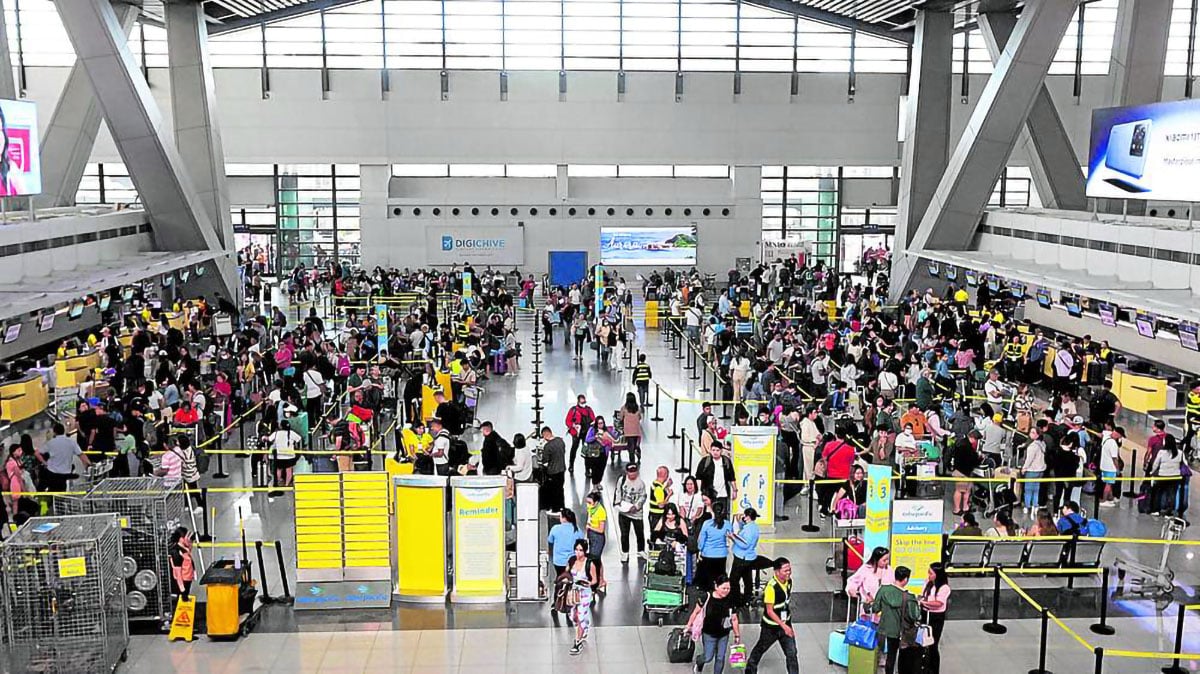
GETTING A GRIP Aside from being known as one of the world’s worst airports, Ninoy Aquino International Airport may also gain fame as one of the most expensive. —Inquirer file photo
MANILA, Philippines — The Department of Transportation (DOTr) on Saturday said the planned increases in fees and charges at the soon-to-be-privatized Ninoy Aquino International Airport (Naia) is based on the 160-percent average increase in consumer price index (CPI) over the last 24 years and the required capital expenditure for the facility’s rehabilitation and capacity expansion.
In a statement, the DOTr said the increase, which supposedly excludes passenger service charges (PSC), was discussed with heads and representatives of the Air Carriers Association of the Philippines (Acap), Board of Airline Representatives (Bar), and Airline Operators Council (AOC) during a meeting on June 11 at the Asian Development Bank, the DOTr’s transaction adviser.
READ: Privatizing Naia
Asia’s most expensive
The Manila International Airport Authority (Miaa), the state corporation operating Naia, planned to impose the hike once the airport is turned over to the private concessionaire New Naia Infra Corp., which won a P170.6-billion contract to rehabilitate and modernize the airport for up to 25 years.
But the aviation groups wrote the DoTr and questioned the “gargantuan” increases, which they said would make Naia Asia’s “most expensive airport” in addition to its disrepute as one of the world’s worst airports.
READ: PH jump-starts Naia privatization as deadline for bids set for Dec 27
The DOTr requested Acap, Bar and AOC to provide “quantified evidence” to their claim that Naia will become the “most expensive airport” in terms of total levied charges per passenger from all aeronautical charges for both international and domestic passengers at Naia.
The department said Transportation Secretary Jaime Bautista, who has been in communication with the groups “deemed the increase in fees and charges necessary and long overdue to be able to rehabilitate Naia and elevate it from its current dismal condition.”
DOTr Undersecretary for Aviation and Airports Roberto Lim said Miaa’s rate increases complied with various Miaa executive orders, joint circulars of the Department of Finance, Department of Budget and Management, the National Economic and Development Authority, and Republic Act No. 9485 or the Ease of Doing Business Act.
In a letter on June 3, 2024, to Acap, Bar and AOC, Lim said “the airport needs very significant capital investment to bring it up to an acceptable service standard for passengers, to improve safety and to increase the number of landing and take-off slots available for airlines.”
He stressed the fees and charges have remained unchanged since year 2000, under Miaa Administrative Order No. 1.
Strong market demand
The DOTr noted the rapid recovery of the airline industry since the pandemic, with total passenger numbers at Naia in 2023 being substantially higher than those of 2018. The department added the volume of current traffic “indicates a need for urgent capital investment to accommodate more traffic, improve operational efficiency, and enhance passenger experience.”
Therefore, the DOTr believes the strong market demand would be able to absorb any additional increase in air fares.
Lim said the planned rate increase was also included in the approved parameters, terms, and conditions specified in the tender documents provided to the bidders for the Naia Public-Partnership Project.
He explained while certain revenues at the airport will be shared with government, the PSC is excluded from the revenue share. He also described the PSC as “one of the largest components of overall airport revenue streams.”
The DoTr said the government is making existing assets and land available to the concessionaire, which was awarded with the contract last March. It is a consortium composed of San Miguel Holdings Corp., RMM Asian Logistics Inc., RLW Aviation Development Inc., and Incheon International Airport Corp.
The concessionaire committed under the agreement to make significant and early capital investments necessary to ensure compliance with the technical specifications and key performance indicators that will result in direct benefits to airlines and passengers.
The Naia privatization project aims to increase airport capacity from 35 million to 62 million passengers annually, increase air traffic movements from 40 per hour to 48 per hour, and elevate the overall the airport’s facilities and services to international standards.